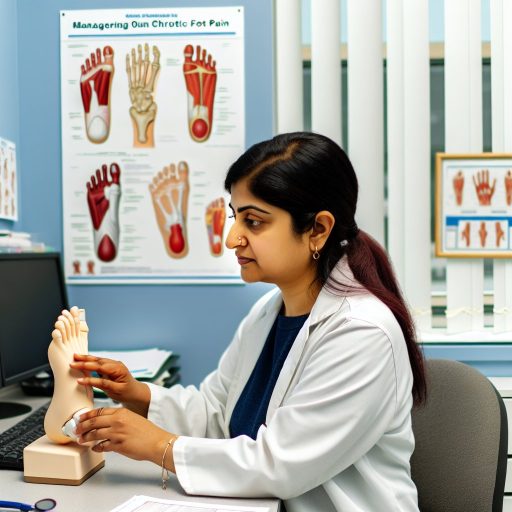Signs You Should See a Podiatrist for Foot Pain
Persistent Foot Pain
If you experience foot pain that lasts more than a few days, consider seeking medical advice.
Persistent pain often indicates an underlying problem that may need treatment.
You may notice discomfort in one or both feet, which can affect daily activities.
Prolonged foot pain can limit mobility and hinder your overall quality of life.
Identifying Symptoms
Look for additional symptoms accompanying your foot pain.
Swelling, redness, or bruising can signal a more serious issue.
For instance, if your foot feels warm to the touch, this may indicate inflammation.
Numbness or tingling sensations might also be present, requiring urgent care.
Impact on Daily Life
Consider how foot pain affects your daily routine.
If it disrupts your ability to walk or stand for long periods, it’s time to consult a podiatrist.
You should not ignore the pain, as it can lead to further complications.
Addressing the issue early can help prevent chronic problems in the future.
Previous Injuries or Conditions
Review your medical history for past injuries or existing conditions.
Conditions like diabetes can affect foot health significantly.
Additionally, past fractures may lead to lingering pain that requires attention.
If you have a history of foot issues, see a specialist regularly for preventive care.
When to Seek Immediate Care
Seek immediate care if you experience severe foot pain suddenly.
Also, if your foot pain is associated with a significant injury, don’t hesitate to act.
Fever accompanying foot pain can suggest an infection or other serious condition.
If you have difficulty bearing weight on your foot, this warrants urgent evaluation.
Swelling, Redness, or Warmth in the Foot Area
Recognizing Symptoms
Swelling in the foot can indicate a serious issue.
It is crucial to monitor any unusual changes.
Redness may signify inflammation or infection.
Additionally, warmth in the foot can reflect increased blood flow.
Understanding Causes
Injury often causes swelling and redness in the foot area.
Unlock Your Career Potential
Visualize a clear path to success with our tailored Career Consulting service. Personalized insights in just 1-3 days.
Get StartedConditions like arthritis can also contribute to these symptoms.
Infection may lead to localized warmth and discomfort.
When to Seek Help
Consult a podiatrist if swelling persists for more than a few days.
Visit a specialist immediately if symptoms worsen over time.
Signs of infection, such as fever, warrant prompt medical attention.
Self-Care Measures
Resting the foot may help alleviate swelling.
Applying ice can reduce inflammation and discomfort.
Elevating the foot can also aid in managing symptoms.
Signs You Should See a Podiatrist for Foot Pain
Pain that Worsens with Activity or Weight-Bearing
Foot pain that intensifies during physical activity is a clear signal that something is wrong.
Many individuals experience discomfort while walking or running.
This type of pain can indicate underlying issues, such as plantar fasciitis or tendinitis.
Additionally, increased weight-bearing activities can exacerbate foot problems significantly.
If you find yourself avoiding activities due to foot pain, seek help from a professional.
Types of Pain to Observe
It’s essential to recognize the different types of pain you may experience.
- Sharp pain during movement
- Aching pain after prolonged standing
- Pain that radiates from the heel to the arch
Each type provides clues about the potential issues affecting your feet.
For instance, sharp pain may suggest a more serious condition that needs immediate attention.
Physical Limitations and Daily Impact
When foot pain begins to limit your daily activities, it’s time to consult a podiatrist.
Simple tasks like walking to the store can become daunting when you have foot pain.
Moreover, ongoing discomfort can affect your overall quality of life.
If you find yourself consistently changing your lifestyle to avoid pain, do not ignore this sign.
Persistent Pain Despite Home Remedies
Many people try to alleviate foot pain using home remedies without success.
If pain persists even after rest, ice, or over-the-counter medication, seek professional advice.
Ignoring prolonged pain can lead to more severe injuries over time.
A podiatrist can provide targeted treatments that are more effective than home remedies.
Discover More: Chiropractic Care For Posture And Back Pain Relief
Difficulty Walking or Abnormal Gait Patterns
Identifying Walking Difficulties
Are you experiencing difficulty walking? This could signal a larger issue.
Many factors contribute to walking difficulties.
Common causes include pain, stiffness, and neurological conditions.
Pay attention to any changes in your movement patterns.
Understanding Gait Abnormalities
Abnormal gait patterns can indicate foot problems.
For instance, limping or shuffling can be telltale signs.
Also, dragging your feet may signal an underlying condition.
Such abnormalities often require professional evaluation.
When to Consult a Podiatrist
If you notice persistent difficulties, see a podiatrist.
A specialist can assess your walking patterns.
They may recommend specific tests to determine the cause.
Addressing these issues early can prevent further complications.
Delve into the Subject: Benefits Of Seeing An Audiologist Regularly
Numbness or Tingling Sensations in the Feet
Recognizing Symptoms
Numbness in your feet can indicate nerve issues.
Tingling sensations, often described as “pins and needles,” are common symptoms.
These sensations may arise suddenly or develop over time.
It is crucial to pay attention if symptoms worsen or persist.
Possible Causes
Several factors can contribute to numbness or tingling in the feet.
- Diabetes can lead to peripheral neuropathy, a common cause.
- Circulation problems may also restrict blood flow to the feet.
- Nerve compression might result from prolonged sitting or standing.
- Injuries to the back or spinal cord can impact foot sensations.
When to Seek Help
Do not ignore persistent numbness or tingling sensations.
Consult a podiatrist if symptoms occur frequently.
Your healthcare provider can assess underlying conditions.
Early intervention can prevent serious complications.
Scheduling an appointment can help you find relief.
Gain More Insights: Kinesiology’s Role in Workplace Ergonomics and Safety
Visible Deformities in Toes or Foot Structure
Recognizing Deformities
Visible deformities in your feet demand attention.
Common signs include bunions, hammertoes, or flat feet.
These conditions affect how you walk and your overall foot health.
Additionally, they can lead to pain and discomfort.
Understanding Bunions
Bunions form when your big toe pushes against the adjacent toe.
This creates a bony bump on the side of your foot.
Over time, bunions can become painful and limit movement.
If you notice this change, seeing a podiatrist is essential.
Identifying Hammertoes
Hammertoes occur when one or more of your toes bend downward.
This condition often results from wearing tight shoes.
Pain and discomfort can arise from friction against footwear.
Consulting a podiatrist can help you find relief.
The Impact of Flat Feet
Flat feet occur when the arches of your feet collapse.
This condition may lead to pain in your feet, legs, or lower back.
A podiatrist can assess your condition and recommend proper support.
Ignoring flat feet can worsen pain and functionality.
Importance of Early Intervention
Addressing visible deformities early can prevent further complications.
Podiatrists can provide tailored treatment plans to enhance mobility.
Ultimately, optimal foot care contributes to your overall well-being.
Discover More: How To Build A Career In Speech-Language Pathology

Recognizing Foot Pain with Systemic Symptoms
Understanding Systemic Symptoms
Systemic symptoms include fever, fatigue, and malaise.
These symptoms may indicate a more serious underlying condition.
Recognizing these signs early can lead to better treatment outcomes.
Foot Pain and Systemic Symptoms
If you experience foot pain along with systemic symptoms, take note.
This combination may signal an urgent need to seek medical advice.
Foot pain alone can stem from various causes, but the added symptoms require attention.
When to Seek Help
Consult a podiatrist if you experience persistent foot pain.
Additionally, if you have any systemic symptoms, schedule an appointment.
A professional evaluation is crucial for proper diagnosis and treatment.
Potential Underlying Conditions
Certain underlying conditions may manifest as foot pain and systemic symptoms.
- Infections can lead to localized pain and systemic reactions.
- Autoimmune diseases might also present with these symptoms.
- Circulatory issues can cause both foot pain and fatigue.
Implications of Foot Pain with Systemic Symptoms
Understanding the signs and symptoms is critical for your health.
Act promptly if you experience these symptoms together.
Timely intervention often prevents complications and improves recovery.
Previous Injuries or Surgeries Affecting the Foot
Importance of Medical History
Your medical history plays a vital role in foot health.
Previous injuries can lead to chronic pain if not properly addressed.
Surgeries may alter normal foot mechanics significantly.
It’s essential to communicate any past incidents to your podiatrist.
Types of Injuries to Consider
Consider previous fractures that may affect your foot’s structure.
Tendon injuries can cause recurring pain and inflammation.
Ligament sprains often lead to instability and further issues.
Each injury has unique implications for your feet.
Signs That Indicate You Should Seek Help
If pain persists after a past injury, take it seriously.
Look for swelling that does not improve over time.
Stiffness in the foot can signal underlying problems.
Difficulty walking or performing daily activities is a red flag.
Post-Surgery Considerations
After surgery, observe how your foot responds during recovery.
Increased discomfort may indicate complications that require attention.
Pay attention to any changes in mobility or function.
Regular follow-ups with your podiatrist can prevent long-term issues.
Preventative Measures
Engaging in rehabilitation exercises can aid recovery.
Wearing appropriate footwear supports foot health post-injury.
Maintain a healthy weight to reduce stress on your feet.
Practice good foot hygiene to prevent infections.
History of Chronic Conditions Impacting Foot Health
Understanding Chronic Conditions
Chronic conditions affect millions of people worldwide.
These conditions often impact overall health significantly.
Common examples include diabetes and arthritis.
Diabetes and Foot Health
Diabetes has seen a dramatic increase over recent decades.
This condition can lead to reduced blood flow to the feet.
Ultimately, it increases the risk of foot ulcers and infections.
Regular foot care is vital for individuals with diabetes.
Arthritis and Its Consequences
Arthritis affects joints, including those in the feet.
This condition often leads to pain and discomfort while walking.
In some cases, it can result in deformities of the feet.
Early intervention can help manage symptoms effectively.
Other Notable Chronic Conditions
Peripheral neuropathy can also impact foot health.
This condition is often associated with uncontrolled diabetes.
It causes numbness and tingling in the feet.
Proper care and treatment are essential to prevent complications.
Importance of Regular Check-Ups
Individuals with chronic conditions should schedule regular foot check-ups.
Podiatrists provide valuable care and advice.
They can identify early signs of complications.
Taking proactive measures can help maintain healthy feet.
Inability to Perform Daily Activities Due to Foot Discomfort
Recognizing Foot Pain
Many individuals underestimate the impact of foot pain.
Yet, this discomfort can greatly hinder daily tasks.
When walking becomes painful, it disrupts your routine.
Consequently, you may find yourself avoiding certain activities.
Identifying Limitations in Daily Tasks
Take note if you struggle to walk long distances.
Additionally, keep track of any difficulty standing for long periods.
You might also notice a reluctance to engage in physical activities.
Even simple tasks like grocery shopping can become challenging.
Observing Changes in Lifestyle
Foot pain often leads to lifestyle modifications.
You may withdraw from social events or hobbies.
Moreover, changes in your exercise routine can signal an issue.
If you notice increased inactivity, consider your foot health.
Understanding Pain Severity
Not all foot pain is the same. Some may be mild while others are severe.
However, persistent pain should never be ignored.
If over-the-counter pain relievers no longer help, seek assistance.
Behavioral Changes Due to Pain
Taking breaks often might indicate underlying foot issues.
Increased irritability can arise from constant discomfort.
Furthermore, altered walking patterns may indicate distress.
When to Consult a Podiatrist
If foot pain interferes with daily living, it’s time to act.
A podiatrist specializes in diagnosing these issues.
Early intervention can prevent more serious conditions.
So, don’t hesitate to seek professional advice.
Additional Resources
Amputation and diabetes: How to protect your feet – Mayo Clinic




